


FREE SHIPPING AUSTRALIA WIDE
Free shipping on all retail orders


AUSTRALIAN OWNED & OPERATED
Licenced WaterMark Supplier
5 Stage Alkaline Undersink Reverse Osmosis Water Filter System (GT1-26-5)
- Enjoy the pure, sweet taste of clean mineralized water on tap!
- 98% Reduction of Common Tap Water Contaminants, Tastes & Odours such as Chlorine, Chloramine, Pesticides, Herbicides, Heavy Metals & Fluoride.
- Improve hydration, energy & muscle recovery with magnesium electrolytes and a pH of 8-9.5.
- Stop buying bottled water & save money!
- Perfect for Chlorinated Town/Mains Water.
5 Stage Alkaline Undersink Reverse Osmosis Water Filter System (GT1-26-5)
The 5-Stage Alkaline Undersink RO system has been designed to suit the needs of customers looking for a high-quality, value-for-money filter. This setup features a sediment and carbon pre-filter (to remove particulate matter, chemicals, tastes & odours), a highly efficient 8-litre-per-hour-capable RO membrane (to reduce heavy metals, fluorides, and salts by up to 98%), and Magnesium & Coconut Carbon post-filters (to provide sweet-tasting drinking water with an alkaline pH of 8-9).
Alkaline Water | The 5 Stages of Filtration
Stage 1: 5 Micron Polyspun Sediment Cartridge (GT2-2N) (Replace Every 6 Months)
The first stage is a 5 Micron (uM) Sediment filter composed of 100% melt-blown polypropylene fibre. This cartridge helps to help protect the carbon pre-filters and reverse osmosis membrane from physical damage caused by particulate matter such as sand, dirt, silt, plant spores, and pollen. Physical contaminants such as these (which can surprisingly be found in most municipal water supplies), tend to clog up filter system components causing reduced water flow, lower osmotic pressure, diminished filtration efficiency, and ultimately, inferior water quality.
Stage 2: 5 Micron 100% Coconut Carbon Block Water Filter (GT4-7CTO) (Replace every 6 months)
The second stage is a high-grade activated coconut carbon block pre-filter. The carbon block matrix enables maximum surface area and contact time, taking the first hit to adsorb chemicals such as Chlorine (which causes damage to the membrane), along with other harmful organic chemicals and contaminants. Keeping up with regular maintenance of this pre-filter (changing it every 6 months) is crucial to protecting and extending the life of all filters that come after it.
Stage 3: 0.0001 Micron Asprinn 50 GPD Reverse Osmosis Membrane (GT36-59) (Replace every 1-4 years depending on water quality)
The RO membrane is the "engine room" of your RO system. All the crucial work is done here, so all the filters before the membrane are primarily there to protect the membrane. This membrane has a 0.0001 Micron rating and can produce up to 190 Litres (50 Gallons) of water per day.
Stage 4: Xstream Alkaline Magnesium Mineral Cartridge (GT6-0) (Replace Every 12 Months)
This filter is made up of pure Magnesium Oxide mineral media, which provides the highest adsorption of mineral content into the water over a 12-month period. The pH ranges from 9.5 (while new) and slowly decreases to around pH 8 toward the end of the filter's life. Imparts a slight "mineral" flavour into the water.
Stage 5: Xstream Carbon 100% Granular Activated Coconut Carbon Cartridge (GT6-11) (Replace Every 12 Months)
This filter ensures the maximum extraction of tastes and odours, whilst imparting a naturally "sweet" flavour into the water.
Optional Add On: Inline Magnetic Water Conditioner (Never Needs Replacing)
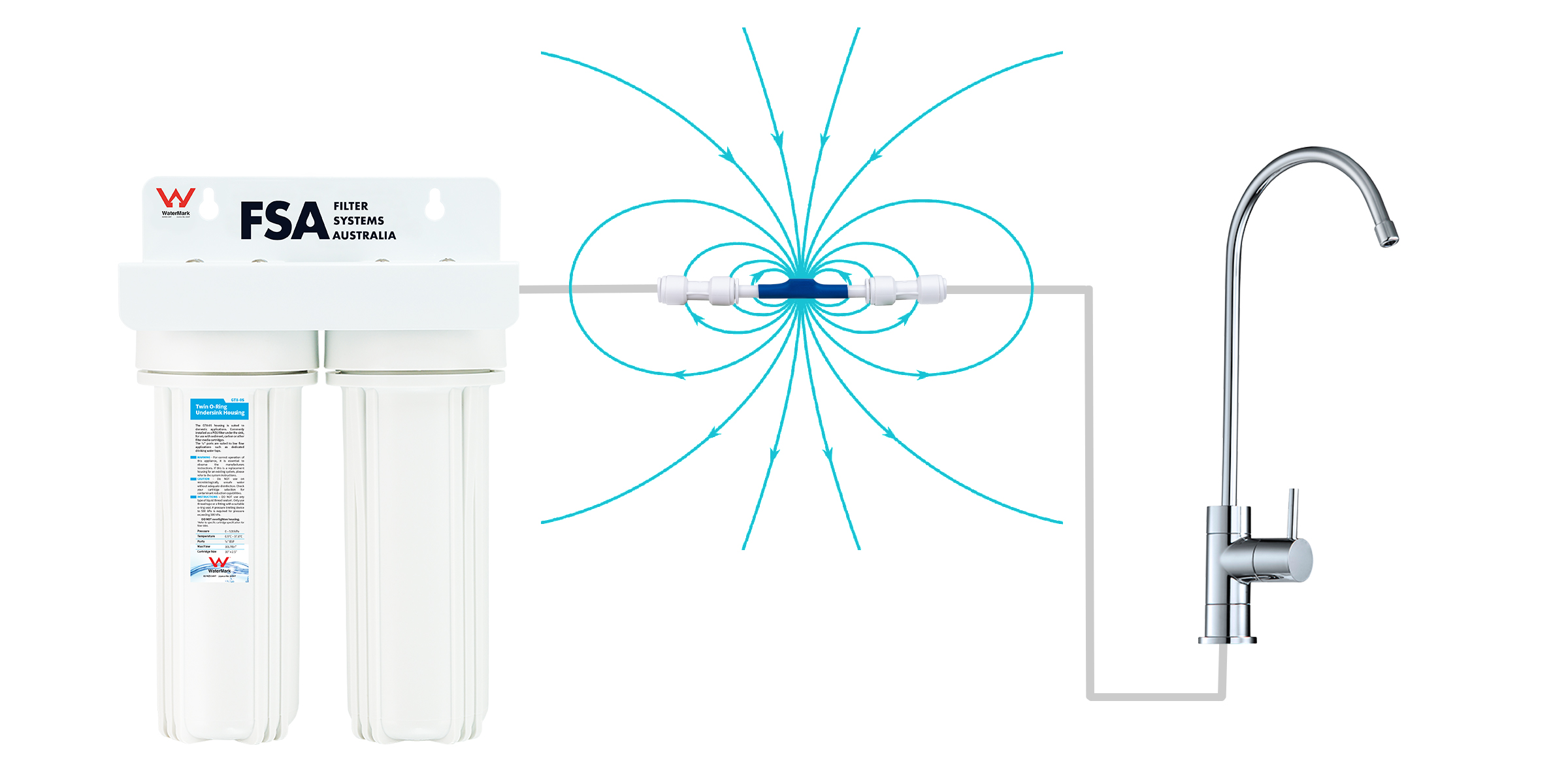
The effects of magnetization on the physicochemical properties of water have been well documented in scientific literature for several decades, with findings ranging from the application of magnets to reduce the growth of limescale in pipes, through to the documentation of magnetically treated water being used to improve the quality and quantity of fruit yield in capsicum plants and increasing the level of oxygen in water to improve hatch rate of fish eggs.
Faucet Tap Options
All of our under-sink RO systems come with a dedicated drinking water faucet tap as standard – which means you will need to drill a hole into your sink or benchtop to install it. Alternatively, you can swap out your current faucet for a 3-way mixer tap, which includes all 3 lines in the one faucet (Hot, Cold & Filtered) – this is a great option for those who don’t want to drill (i.e. if you have a stone benchtop), and it also looks nice and minimalistic. If you would like to explore our range of faucets and mixer taps in better detail, please click the below:
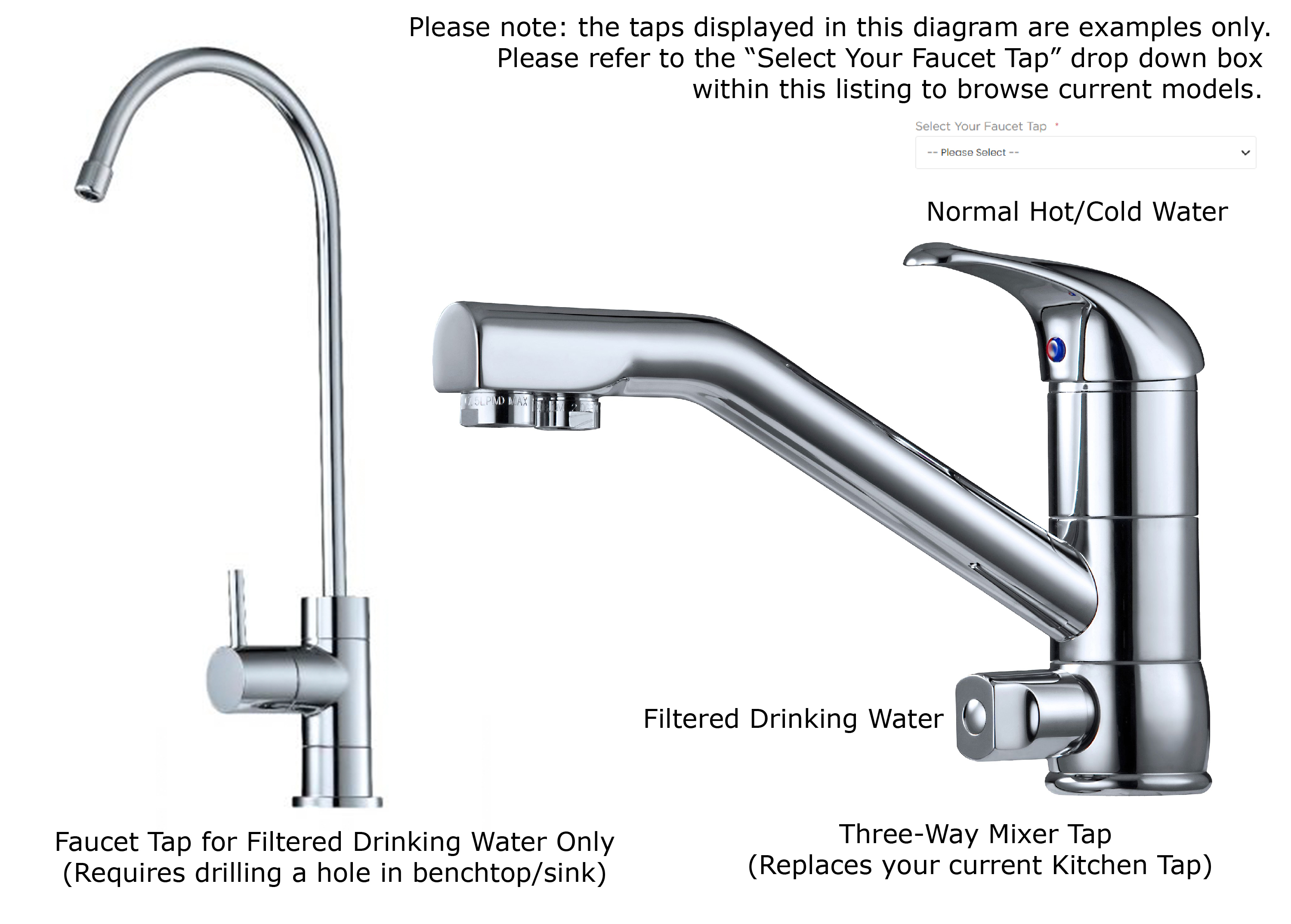
RO Water Storage Tank Options
Because Reverse Osmosis membranes filter down to such a fine micron rating (0.0001 of a micron), they produce water at a very slow rate (on average 8 litres PER HOUR). This is why all plumbed-in RO systems come standard with a dedicated drinking water tap, and a water storage tank. Your water usage requirements and under-sink space can help determine which sized tank to choose from. Consider that the average person should drink 2L of water per day, and that the system will automatically re-fill at a rate of 8 litres per hour. Choose from a 6L, 8L or 12L tank - the tank dimensions can be seen in the image below:
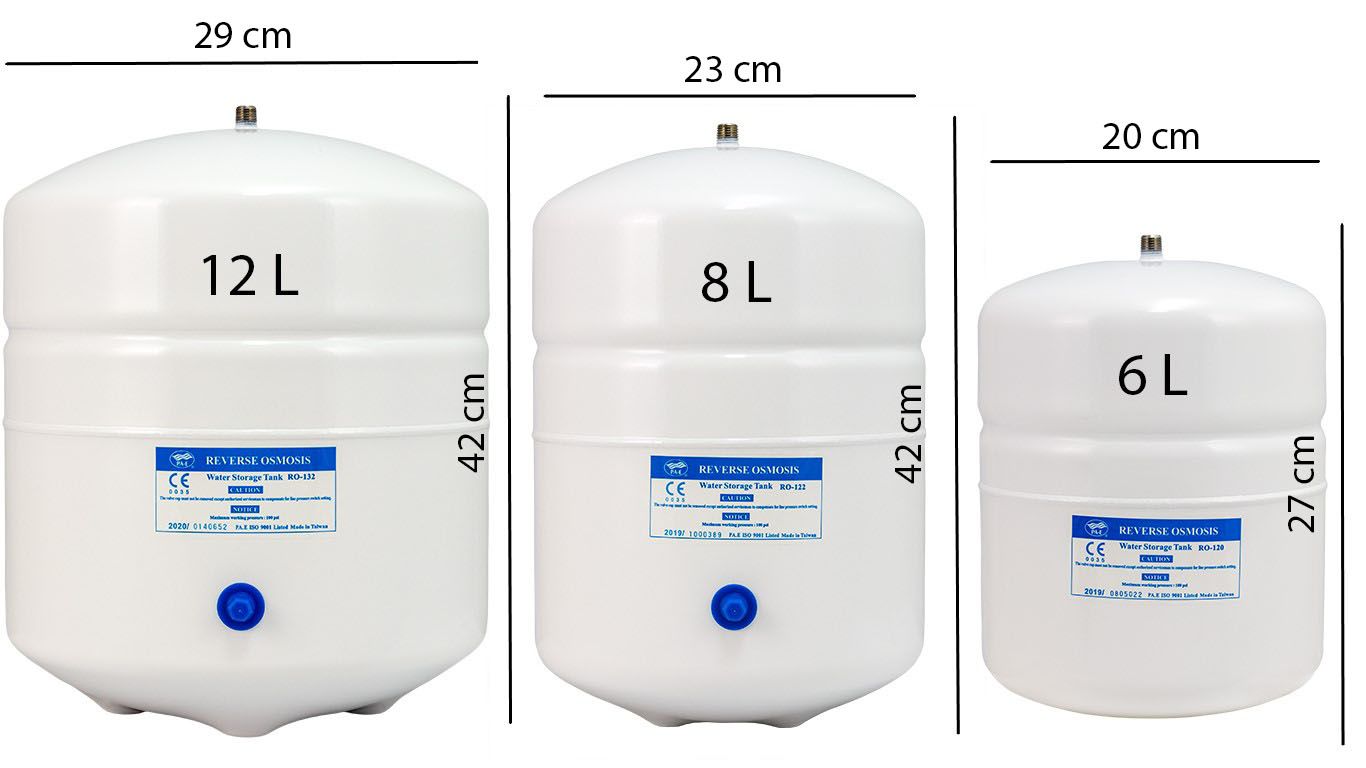
Please refer to the "Specs/Performance" Tab for system dimensions.
Watermark Certification
This RO system is certified to WaterMark Standards AS/NZS 3497 under Certificate Number 23247. WaterMark certification is the level of certification required by law for a licensed plumber in Australia to install a water filtration system. All products used under this certification will give you peace of mind knowing that your water filter complies with Australian plumbing codes. Our WaterMark Certified filter systems are hand-assembled here in Australia and are randomly batch-tested to ensure top quality and workmanship for your water filtration products. Do not trust products that do not have WaterMark Certification - they can be hazardous and may result in denied insurance claims due to Australia's Plumbing & Drainage Laws.
INSTALLATION - Please note this system is WaterMark Certified to Australian plumbing standards (AS/NZS 3497), and will need to be installed by a licensed plumber. Simply order online with free shipping to your home, and once it arrives any local licensed plumber will be able to do the installation (the system also comes with instructions)!
IMPORTANT INFORMATION ABOUT REVERSE OSMOSIS
Our Thoughts On Fluoride
Whether or not you agree or disagree with the fluoridation of Australian Tap Water, most municipalities in Australia have adopted the practice of adding fluoride due to its dental health benefits. Fluoride has been proven to help remineralise and strengthen the tooth enamel to prevent cavities and tooth decay with incredible effectiveness, hence why it is the most common ingredient in mainstream toothpastes! However, too much fluoride (or exposure to fluoride in childrens' developing teeth) can cause dental fluorosis - a condition characterised by unsightly discolorations and small white spots visible on the surface of the tooth. Whilst rare, fluorosis can actually damage the surface of undeveloped teeth, weakening them in the long run.
Dental Fluorosis of the teeth.
Of course, as with any miracle of modern medicine, it is true that "the dose makes the poison". At high doses, Fluoride is a proven neurotoxin - as shown in countless credible studies - and this is why all fluoridated toothpastes must list the fluoride content and warn you not to swallow it! However, in spite of its clear dental health benefits, a simple Google Scholar search of academic research articles on "chronic exposure to fluoride" will help educate you on what is currently known about the long-term consequences of ingesting fluoride. Fluoride is good for your teeth, but do you really want to be consuming it?
Reverse Osmosis Water Filtration is the safest and most effective solution to remove fluoride from your drinking water, as fluoride is a Mineral Salt. Mineral salts will pass straight through standard sediment and carbon filtration, however, using a 0.0001 Micron reverse osmosis membrane offers a 98% reduction in fluoride (in addition to heavy metals and salts).
(Fun Fact: Fluoride isn't the only compound capable of remineralising your teeth! For example, in Japan, one of the most popular toothpaste brands (Apagard Toothpaste by Sangi Co.) was originally developed for NASA and used by astronauts in space! This toothpaste contains a calcium phosphate mineral compound called Nanohydroxyapatite (Nano-HA or nHAP) - a totally natural, bio-compatible substance that mimics the natural calcium hydroxyapatite structure of teeth and bone, penetrating deeper than fluoride to strengthen (and whiten) the tooth more effectively and without the negative effects of fluoride!)
Re-Mineralising & Alkalising - What Does It Mean?
Reverse Osmosis Water Filtration has long divided public opinion with common myths such as "RO water is too pure", "RO leaches minerals from your bones" and "RO removes beneficial minerals". However, Reverse Osmosis technology has been risk-assessed by the WHO and safely used for many decades to supply water to the public in places where fresh water is scarce. For example, many people already know that RO technology is used widely in the Middle East and in sub-marines to turn salty ocean water into fresh drinking water... but did you know Australia also has seven desalination plants that supply water to Sydney in NSW, the Gold Coast in Queensland, Adelaide in South Australia, Dalyson in Victoria, and in Perth, Cape Preston, and Binningup WA? You might already be drinking RO-filtered tap water in your home and not even know it!
The misconception that water can be “too pure” has to do with the pH chemistry of water. Water that is “too pure” is simply water that contains little to no mineral content. The way Reverse Osmosis works is by filtering down to such a fine micron rating (0.0001) that almost all dissolved metals, minerals, and salts are removed - leaving you with incredibly pure water. However, the absence of minerals leaves the water with an acidic pH of around 5-6. Now, it's common knowledge that acidic drinks (such as soft drinks and alcohol) are proven to corrode tooth enamel (perhaps that's where the myth of "RO leaches minerals from your bones" originates), and hence why we don't recommend you drink acidic RO-filtered water straight out of the membrane! Instead, the solution is to use a "post-filter" after the membrane to add the minerals back in and bring the pH and alkalinity back to a non-corrosive state!
Now, this is where we will myth-bust the idea that "RO removes beneficial minerals". When we consider nutrition, minerals come in two main forms - inorganic minerals and organic mineral compounds. The inorganic form is basically a mineral electrolyte in its raw state (i.e. directly from the earth), but on its own, inorganic minerals are negligibly bioavailable. Plants turn inorganic minerals into organic mineral compounds via photosynthesis - hence why fruits and vegetables are so nutritious! Animals and humans also have the ability to transform inorganic minerals into bio-available organic mineral compounds through the digestive process (i.e. chelation in the stomach). It is commonly known that vitamin C improves the absorption of iron, which is a great example of how chelation works! To give you another perspective, spinach is considered to be one of the most magnesium-rich foods (79mg of magnesium per 100g). When we consider that (as an example) Gold Coast Tap Water contains on average, a mere 4.2mg of magnesium per litre of water - you'd have to drink 18 litres of water to get the same amount of magnesium!
As with anything we consume, digestion is never 100% efficient! So, the reality is that YES - even though RO removes minerals, and even though the post-filter remineralises the water, and even though the human body has the ability to convert inorganic minerals into organic mineral compounds - you still get more mineral nutrition from eating wholesome pre-digested readily bio-available organic minerals in meats, fruits, and vegetables than you do from drinking water!
How often should you change reverse osmosis water filters?
Filter Replacements & Maintenance Schedule
To maintain the optimum level of filtration year-round, and to ensure you get the maximum life out of your RO membrane (the engine room of this system), we strongly recommend a consistent filter maintenance schedule.
-
Pre-Filters
Every 6 months you will need to change the pre-filters, which help protect and extend the life of the membrane. Some people neglect to keep up with the maintenance of the pre-filters, thinking that the RO membrane will take care of it! However, the RO membrane is the most delicate and expensive filter within any RO system, so it's worth protecting your investment!
The pre-filters thus serve the dual purpose of blocking sediment particles larger than 5 microns and removing chlorine, which both cause damage to the inside of the RO membrane in different ways:-
Sediment particles physically damage the fine internals, causing micro-tears that allow contaminants through to the "clean" side of the osmotic membrane, as well as blocking up the membrane which can cause the system to stop producing water and force an excessive amount of water to waste.
-
Chlorine that has been dissolved in water creates corrosive hypochlorous and hydrochloric acids, which dissolve the delicate RO membrane (via a process called "ring chlorination" which disrupts the hydrogen bonding between the membrane's polymer matrix) and allows contaminants to pass through to the "clean side". Because this process occurs gradually over time, most people don't notice the taste of contamination until they change their membrane!
-
-
Reverse Osmosis Membranes*
Reverse Osmosis membranes filter down to an ultra-fine level of filtration - down to 0.0001 of a micron - which is the reason why RO membranes can filter out minerals, salts, and metals (unlike carbon). Because this level of filtration is so fine, RO membranes do eventually clog up over time. How long you will be able to get out of your RO membrane, depends on the consistency of your membrane pre-filter maintenance, along with the starting quality of your water.
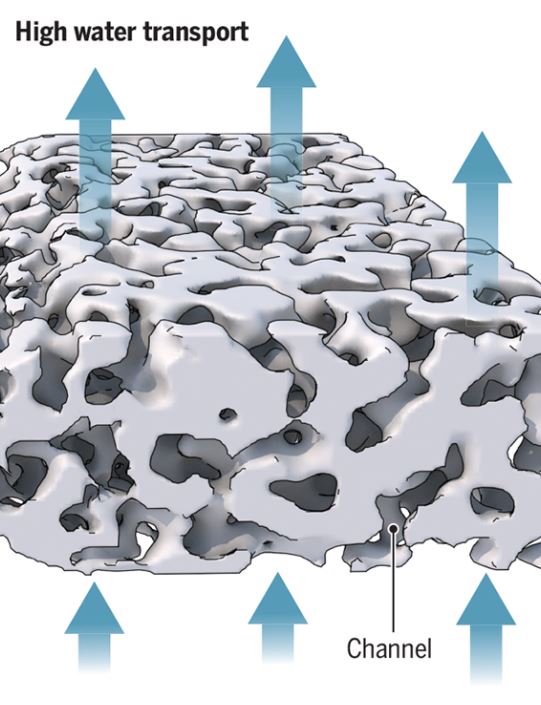
(Adapted from Geise, G.M., 2021, found in https://www.science.org/doi/10.1126/science.abe9741)
-
- HARD WATER (water that is full of salts and minerals) takes a bigger toll on RO membranes than water that is SOFT (water with a low Total Dissolved Solids rating).
-
Western Australia, South Australia, the Northern Territory and Queensland tend to have hard water, along with those whose main source of water comes from a bore.
-
Thus, whilst we have specified a recommended maintenance schedule (below), the quality of the water in the area you live, is ultimately what will determine how long you get out of your RO membrane.
-
*If you are on hard water, at the 2-year mark, simply go for the FULL Replacement Pack (which includes an RO Membrane). Note - cases of extremely hard water may get less than 2 years out of an RO membrane.
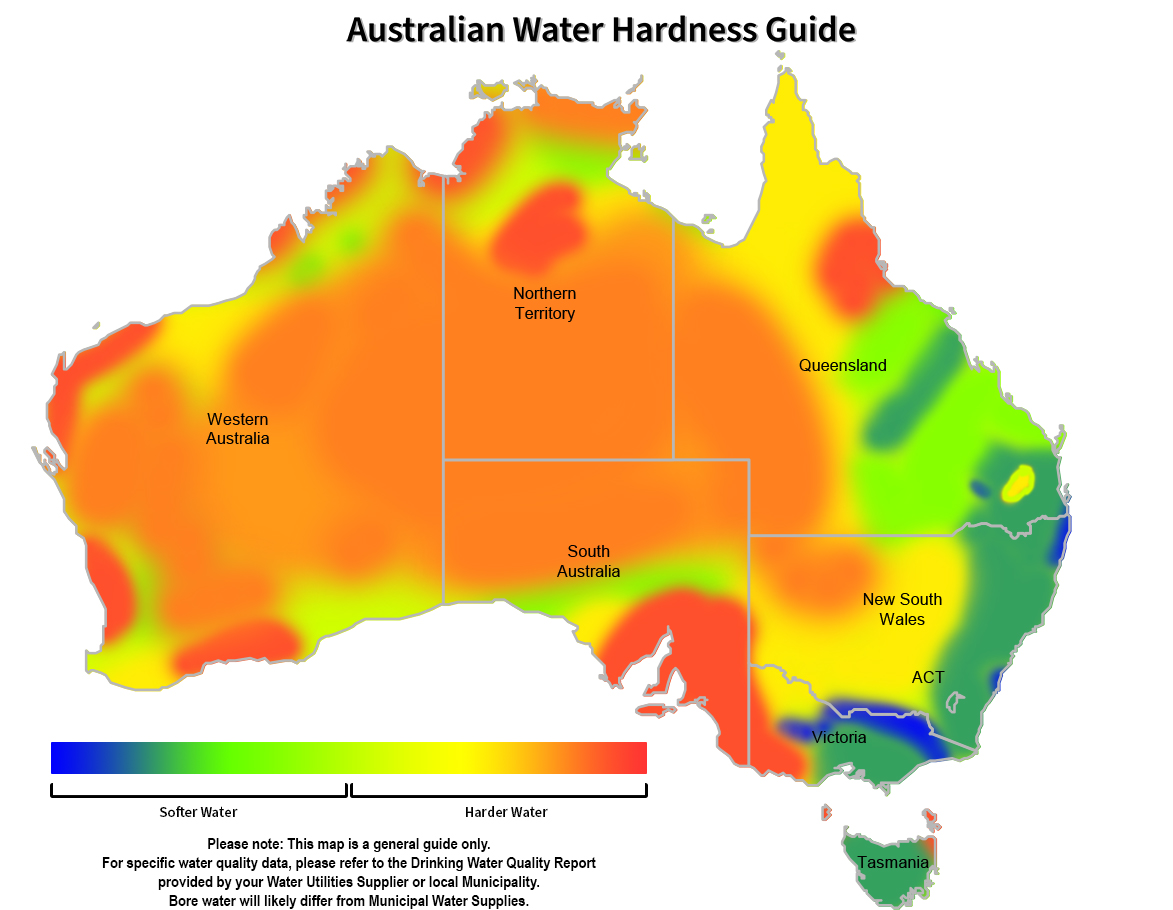
-
Post-Filters
These are all filters that go after the RO membrane to buffer the pH back up from an acidic state to an alkaline state, and "perfect" the water for final consumption. Over the course of a year, the diffusion of the alkalising minerals into the water will significantly diminish, whilst the carbon post-filter will eventually exhaust its capacity to adsorb residuals.
Please see the Recommended Filter Replacement Schedules (per the above) and links to the replacement filters:
HARD WATER - Recommended Filter Replacement Schedule*
- Every 6 Months - Pre-Filter Replacement Pack
- Year 1 - Pre- and Post-Filter Replacement Pack
- Year 2 - FULL Replacement Pack - Pre & Post-Filters + Reverse Osmosis Membrane*
MODERATE/SOFT WATER - Recommended Filter Replacement Schedule*
- Every 6 Months - Pre-Filter Replacement Pack
- Year 1 - Pre- and Post-Filter Replacement Pack
- Year 2 - Pre- and Post-Filter Replacement Pack
- Year 3 - Pre- and Post-Filter Replacement Pack
- Year 4 - FULL Replacement Pack - Pre & Post-Filters + Reverse Osmosis Membrane
***IMPORTANT INFORMATION ABOUT WATER SANITATION FOR RAIN/BORE WATER SOURCES***
PLEASE NOTE: REVERSE OSMOSIS SYSTEMS PERFORM OPTIMALLY ON CHLORINATED (MAINS/TOWN) WATER, AS THE PRESENCE OF CHLORINE KILLS THE BACTERIA/FUNGI/YEAST. THEREFORE, REGULAR & CONSISTENT WATER DISINFECTION IS STRONGLY RECOMMENDED FOR RAIN/TANK/POTABLE BORE WATER* SOURCES PRIOR TO USING A REVERSE OSMOSIS FILTER SYSTEM. FAILURE TO ADEQUATELY DISINFECT THE WATER WILL RESULT IN BIOFOULING OF THE RO MEMBRANE (I.E. A BACTERIA/FUNGUS/SLIME COLONY WILL START GROWING INSIDE THE MEMBRANE WHICH WILL PUTREFY YOUR FILTER SYSTEM & RENDER THE RO MEMBRANE UNSALVAGEABLE).
For Protection Against Bacteria/Fungi/Yeast
Bacteria (such as E.Coli) can colonize in the stagnant water and result in harmful illnesses when consumed. For sanitation against common water-borne bacteria/viruses in rainwater and potable bore water*, we, therefore, recommend dosing your tank with a product such as Hydrosil Ultra 7.5% Water Sanitiser to ensure protection against microbiological contamination/biofouling in your pipework and/or filter system.
HydroSil is a food-grade silver-activated, hydrogen-peroxide based water sanitiser, which acts to oxidise bacteria, yeast, fungi & viruses, without leaving any dangerous residues behind. HydroSil sanitizes and protects your tanks and water storage devices, making rainwater and potable bore water safe and suitable for human consumption. HydroSil is not a chlorine-based chemical like most sterilisers on the market today. It is non-toxic, and safe to use around your home and family.
Dosage Rate: HydroSil should be dosed at a rate of 200mL per 1000L of water. To scale down to tank size, you will require 20mL per 100L.
Buy Hydrosil Ultra 7.5% Here:
About Rain Water
Australia is the world’s driest inhabited continent, and an astonishing 10% of Aussies don’t have access to a mains water supply, so it’s no wonder why rainwater and bore storage tanks are so popular in rural areas to save water during drought and for household use all year round in cooking, cleaning, gardening, bathing and sometimes even drinking. However, whilst many people enjoy the sweet taste of rain and spring water, and some even swear by the ‘raw water’ trend (which proponents (sometimes falsely) believe has more minerals and fewer contaminants than regular chlorinated town water), we cannot stress enough that drinking untreated water is a very bad idea!
Scarily, in Australia, the general public perception is that rainwater is pure, clean, and safe to drink, but according to the Australian Environmental Health committee’s Guidance of the Use of Rainwater tanks, the fact is that the microbial quality of tank-collected rainwater is typically worse than regular urban tap water, and not to mention, the chemical quality of rainwater can be negatively impacted for those living near heavy industry or in areas with heavy traffic emissions. For example, rainwater samples in Port Pirie, South Australia, (which has one of the world’s largest lead smelters), have been found to contain levels of lead that exceed Australian Drinking Water Guidelines by up to ten times! Even bushfire can contaminate rainwater! And that’s not to mention the microbiologically sickening soup of bacteria, viruses parasites that inevitably make their way into your tank from disease-spreading insects such as mosquitoes, the excrement and decaying carcasses of frogs, snakes, rodents, and possums that commonly live in and around tanks, and the droppings from bats and birds flying overhead! Also consider that bacteria tend to proliferate in moist and warm environments, meaning that warmer weather, in particular, has the tendency to turn your tank into a putrified bacterial breeding ground. Thus, whilst rainwater may smell odourless, taste great, and look clean and clear to the naked eye, with the human senses alone, you simply cannot tell what potentially harmful microscopic contaminants could be lurking in your tank water (even after filtering the water with carbon) – and you certainly don’t want to be drinking it!
Do you need to treat your rainwater tank for safe drinking? As an alternative to constantly dosing your tank, click here to check out our range of Ultraviolet Water Sanitation Systems!
About Bore Water
Bore water will always require filtration, as whilst you would think it is “naturally purified” to some extent as the water seeps through the aquifer via various layers of bedrock, this water is highly susceptible to contamination by bacteria, viruses, parasites (see: Brain-Eating Parasites), sewerage (think human excrement, cleaning and bathing products), chemicals, fertilisers, pesticides, minerals, heavy metals (such as lead, zinc, chromium, copper, cadmium, arsenic and nickel), and sometimes even radioactive elements (such as uranium) from both natural sources and human activity. As with rainwater treatment, the most cost-effective solution is typically to use 5 Micron Carbon Filtration in combination with UV Sterilisation to ensure 99.9% eradication of all parasites, bacteria, viruses. However, this system is not always a "total fix", as bore water chemistry is incredibly complex, and sometimes may not even be treatable. Yet another common misconception we often encounter is that carbon can filter out anything and everything – but unfortunately, carbon doesn’t kill bacteria or remove minerals, salts and other such dissolved inorganic substances!
We STRONGLY recommend that you get your bore water tested to determine if there are any underlying issues in the water chemistry of your bore, before you make any purchases or try to filter it. If you have not had your water tested yet and would like to get this done, please contact us to have your bore water analysed.
SPECIFICATIONS
System Dimensions:
Height: 43cm
Depth: 21cm
Width: 37 cm
NOTE: If height is a problem, you can detach the top 2 filters and place beside the system – this will reduce the total height to 39.5cm
Storage Tank Dimensions 12L:
Tank Height: (with stand) 41cm
Tank Height: (without stand) 38.5 cm
Tank Width: 27 cm
Kit Contains
- 4 Stage Watermark Certified RO System
- Filters Included
- 12L Storage Tank
- 2m White Tubing
- 2m Black Tubing
- 2m Yellow Tubing
- 2m Blue Tubing
- Tube Cutter
- Thread Tape
- Quick Connect Faucet Adaptor
- Dual Opening Spanner
- Inlet Water Valve
- Pressure Limiting Valve
- Goose Neck Faucet
- Drain Saddle
RO Performance:
Inorganic Organic Rejection Aluminum 98% Adrazin Over 98% Arsenic 98% Aldrin Over 98% Benzene Over 98% Barium 95% Chlorine Over 98% Cadmium 95% Chloroform Over 98% Calcium 98% DOT Over 98% Chloride 95% Dichlormethane Over 98% Chromium VI 98% Endrin Over 98% Copper 98% Fluoranthene Over 98% Fluoride 99.9% Herbicides Over 98% Iron 98% Lindane Over 98% Lead 98% Methoxychlor Over 98% Magnesium 98% PCB Over 98% Manganese 98% Pesticides Over 98% Mercury II 85% Perchlorethylene Over 98% Nitrate 90% Phenole Over 98% Potassium 95% Tannic Acids Over 98% Selenium IV 95% Toxaphene Over 98% Silver 98% Trichlorethlene Over 98% Sodium 95% Trihalomethanes Over 98% Strontium 98% V.O.C.'s Over 98% Sulphate 98% Total Dissolved Solids 95% Zinc 98%
Faucet Tap:
The Faucet tap supplied standard with this kit is Compliant to NSF/ANSI 61
Return Policy
Due to the nature of the products we sell, a strict return policy is in place. We work with food grade certified materials that must be un-opened and un-used as to be able to be re-sold.
You may receive a refund or credit of equal amount, less the restocking fee if applicable and any other deductions that are relevant.
- Wrongly purchased items may be returned for a merchandise credit, this applies for but not limited to: Wrong size, wrong system etc.
- 30 Day return Policy: Returns will not be accepted without prior approval or after 30 days of invoice date.
- All returns will incur a 17.5% restocking fee or cost to send the item to you whichever greater. FSA may use discretion to determine the restocking fee.
- Any damages (minor, that can be repaired) will incur a fee which will be deducted from the total refund which will be equal to the cost of the replacement
parts (List Price) and labour charge (if applicable) to repair the system(s). This will be separate to the restocking fee. - Any damage considered to be major and not feasible for repair may be refused and the return request will be void. The customer will be responsible for the return freight or disposal of the damaged unit.
- Return shipping is to be paid by the buyer to the address provided. It is recommended that the customer applies transit warranty to the return freight in case of damage.
- Any damages to the system that were not reported to FSA within 48 business hours of receipted delivery are not covered under our transit warranty.
- Should the item appear faulty or doesn’t work how described, the unit/item must be returned for testing (if requested), the return postage paid by the buyer. If the unit/item is deemed to be faulty, compensation will be provided for the postage cost (Proof of cost required). If the unit/item is deemed to be in working order and as described, the buyer will responsible for return postage.
If you have any questions about our return policy, please contact us before purchase. This will also help to ensure you purchase the correct product that suits your requirements.




